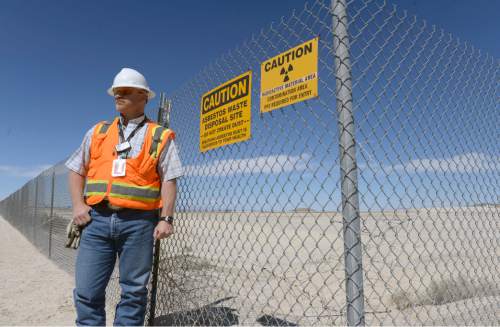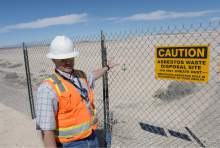This is an archived article that was published on sltrib.com in 2015, and information in the article may be outdated. It is provided only for personal research purposes and may not be reprinted.
Clive • The barrels look harmless enough.
Tucked away in a sterile metal shed in the middle of Utah's West Desert, the 55-gallon plastic drums show no hint of what lies beneath the metal lids — radioactive waste that will only get hotter over time.
EnergySolutions executives hope the 5,400 containers eventually will become a waste stream that could sustain the company for years — approximately 250,000 metric tons of depleted uranium in all.
The waste-management company has prepared a burial ground for the stuff — a vast pit, 10 feet deep, where tens of thousands of the drums would be lined up and covered in concrete, clay and rocks.
Forever.
Or at least as far into the future as humans can plan.
Now, state hazardous-waste managers have to sign off on the idea.
EnergySolutions' proposal to allow the U.S. Department of Energy to send up to half its depleted uranium to a Tooele County landfill 80 miles west of Salt Lake City is nearing final approval.
On Monday, the Utah Department of Environmental Quality (DEQ) will release an evaluation of the company's ability to keep the uranium safe. At the same time, DEQ wants to hear Utahns' thoughts about the plan. Public hearings are scheduled in early May.
For decades, stockpiles of the waste — just one legacy of the nation's nuclear bomb-making binge — have defied permanent disposal because of concerns about long-term risks. When you're projecting thousands of years of radioactivity, no one is 100 percent sure what that means for Earth's inhabitants.
"It's a sticky, complicated issue. There is a lot of fear surrounding it," said DEQ Executive Director Amanda Smith during a recent visit with The Salt Lake Tribune editorial board.
But EnergySolutions Marketing Vice President Mark Walker says the company simply is fixing a problem all Americans helped create.
"As a country, we generated this," Walker said. "We all benefited from nuclear science, whether it's through medical research or cancer treatments, energy [or defense].
"The nuclear bomb was developed to protect our country," he added. "To responsibly manage it limits the risk for everybody."
Whether the company's plan is responsible is a point of debate.
—
Dread and buried • Depleted uranium, or DU, is considered a low-level hazard today, but it becomes progressively more radioactive over thousands of years, posing an environmental hazard deep into the future, long after the civilization that produced the waste disappears.
Right now, the waste — 750,000 metric tons — is being stored at three U.S. Department of Energy sites, in South Carolina, Kentucky and Ohio.
If EnergySolutions' bid is successful, the pit in Clive, the nation's largest radioactive-waste landfill, will be one of three permanent storage repositories for the nuclear waste.
EnergySolutions' disposal plan is low-tech.
The company proposes digging 10 feet down, lining an 80-acre cell with a two-foot layer of clay and stacking depleted uranium drums four or five deep, up to ground level. Other wastes and capping material would take the mound to 38 feet above grade.
When completed 30 years from now, the depleted uranium cell would look much like the two completed landfill cells on site.
Each layer would be encased in concrete that would eliminate all voids and stabilize the drums, acting just like grout between tiles, said David Squires, EnergySolutions operations manager.
Layers of drums would stack up like a slope-sided mound before the whole thing is covered with a clay layer that would act as a radon shield. On top, future crews would stack three feet of rocks.
In theory, the dirt and concrete would stay in place forever, protected from the elements, vandals, earthquakes, floods.
In reality, HEAL Utah Director Matt Pacenza asks, how can anyone know?
"You're burying dangerous material just below the surface for 2 million years, when it reaches its peak hazard," Pacenza said. "No one can say with a straight face that 'there is a reasonable assurance the potential dose will be below the regulatory standard.' "
—
Future shock • EnergySolutions is not the first to propose storing hot nuclear waste in Utah's West Desert.
For years, the Skull Valley Band of Goshutes offered tribal land as an alternative to Nevada's Yucca Mountain nuclear-storage site, pledging to take up to 44,000 tons of depleted nuclear-power plant fuel rods. In the end, the U.S. Bureau of Indian Affairs and the Bureau of Land Management scuttled the idea.
For EnergySolutions, DEQ's analysis is a key milestone in the nuclear-waste processor's plan to entomb up to half the feds' depleted uranium stockpiles. The company has been pushing the idea for 10 years.
While many Utahns want to keep the waste out, EnergySolutions officials contend there is no better place or way to dispose of depleted uranium.
"The greater risk is not managing the material responsibly," Walker said.
He believes Utahns should set aside their emotions and decide the question based solely on the science.
Smith says that's what Gov. Gary Herbert plans to do.
"The governor's position has been: We are going to let the science decide the issue," she said, "whether the site can safely handle the material and under what circumstances."
Critics argue depleted uranium is increasingly radioactive for so long, the company and the state cannot foresee what might change in Clive during the next 100 years, let alone the next million years.
EnergySolutions, they say, is exploiting a bureaucratic loophole to avoid Utah's prohibition against more dangerous Class B and C waste. Right now, the depleted uranium is lower-radiation Class A waste allowed at Clive. Over time, as it gets hotter, the stuff would qualify for waste categories Utah blocks from entering the state.
And the science is anything but settled on what will happen at Clive in the next million years — a realistic window with depleted uranium.
Many scientists believe the region's climate will be cyclical — dry now, but wet in the future. Lake Bonneville could return and inundate the site sometime during the next 100,000 years, according to Helge Gabert, a program manager with the Division of Solid and Hazardous Waste.
"If that happens, the embankment will be obliterated and [depleted uranium] could be dispersed, or as the lake recedes, it could be wind-borne," Gabert said. "Whatever would live here at that point in time would be affected."
The company's current shallow burial plan doesn't leave much room for error.
"One of our conditions is that it be buried below grade," Gabert said. "But since there is a shallow aquifer 20 to 25 feet below grade, that doesn't leave much room."
Walker says projecting thousands of years into the future is speculative, at best. Besides, he argues, the return of Lake Bonneville wouldn't threaten the Clive landfill cells.
"The geologists say no," Walker said. "As the lake raises, the sediment bed is going to raise. The sediment is going to cover that.
"Clive is at a higher elevation than Salt Lake City," he added. "If Lake Bonneville starts to cover Clive, we have much larger issues to worry about."
Pacenza argues the waste can be safely stored only at deeper, more secure depths. "You have to keep this stuff deeply buried away in a mountain."
Walker counters that no mountain is currently available. Besides, he says, DOE picked Clive as the best among 29 sites studied.
EnergySolutions studied a 10,000-year time frame to show the cell would still be intact — despite major changes to the environment around it.
Pacenza figures that such a narrow study window rigs the assessment to conclude the uranium cell would not harm anyone.
"We cannot guarantee that there will be signs and fences for future civilization to know that this area is dangerous," he said. "You are condemning future generations to unknowingly coming into contact with it. Those structures will certainly be gone. That is why we say near-surface disposal is the wrong answer for this material."
—
The deciders • Two other landfills are qualified to accept the depleted uranium — Waste Control Specialists in west Texas and the Department of Energy's Nevada Test Site. Walker said the federal stockpiles would be transported by rail in roughly equal portions to all three disposal sites.
In 2006, DOE shipped the 5,400 drums to Clive from its Savannah River, S.C., site, triggering a controversy about whether Utah should accept such waste.
Separate from the Savannah River waste, the company already has buried 49,000 tons of DU from past disposal contracts.
The state put a stop to further shipments, insisting EnergySolutions needed an amended license.
Since then, the drums have been moved twice. Now, they are stored in a massive warehouse on a site built on DOE's dime. Instead of paying a one-time storage fee, the feds are paying rent to keep a roof and secure walls over the drums.
According to Gabert, some of the waste is contaminated with radioactive technetium 99. Drums with that waste may have to be sent back because Utah law bars landfilling that waste if it exceeds certain radiation thresholds.
Another deal-breaker for the state could arise if the federal Nuclear Regulatory Commission reclassifies depleted uranium.
"It is extremely troublesome to us," Smith said, "that their own people have been publicly saying [depleted uranium] is probably greater than Class C, particularly when you look at taking large quantities."
Whatever happens, the DEQ boss says, the federal government will be on the hook to maintain the site — forever.
"Before we accept the waste," she said, "they would enter into an agreement with DOE for the long-term stewardship of the cell that houses the [depleted uranium], meaning [the feds] would own and take care of it in perpetuity."
Ultimately, the decision whether to allow the waste into Utah will be made by Division of Radiation Control Director Rusty Lundberg. Neither the Radiation Control Board, which soon will merge with the Solid and Hazardous Waste Board, nor the governor will have a say.
Smith believes whatever Lundberg's decision, it will be followed with an administrative appeal and then a lawsuit.
"My gut feeling," Smith said, "is you either believe it matters what we do in a million years, or it doesn't."
What is depleted uranium?
Most of the uranium needed to produce nuclear weapons and fuel rods becomes a worthless byproduct, stripped of the isotopes used in fissionable material. When uranium is enriched, the U-235 is siphoned off, leaving behind a waste that is heavy with U-238. It is currently categorized as Class A, the least-hazardous nuclear waste. Over time, however, the material becomes more radioactive, reaching a peak after 2.1 million years. The U.S. Department of Energy has stockpiled 750 metric tons at three federal sites: Savannah River, S.C.; Paducah, Ky.; and Portsmouth, Ohio.
#
Public comment
The Utah Department of Environmental Quality is evaluating a controversial proposal by EnergySolutions to store tons of depleted uranium at its Clive landfill for low-level radioactive waste. A six-week public comment period opens Monday, giving Utahns a chance to weigh in on the state's analysis of the suitability of EnergySolutions' west desert site for safely storing the waste.
Two public hearings, one in Tooele and another in Salt Lake City, have been scheduled:
May 6 • 6 p.m., Tooele County Courthouse, 47 S. Main St.
May 7 • 6 p.m., Salt Lake City, DEQ boardroom, 195 N. 1950 West.
The hearings run until 8 p.m. and are preceded by informational meetings at 5 p.m.





